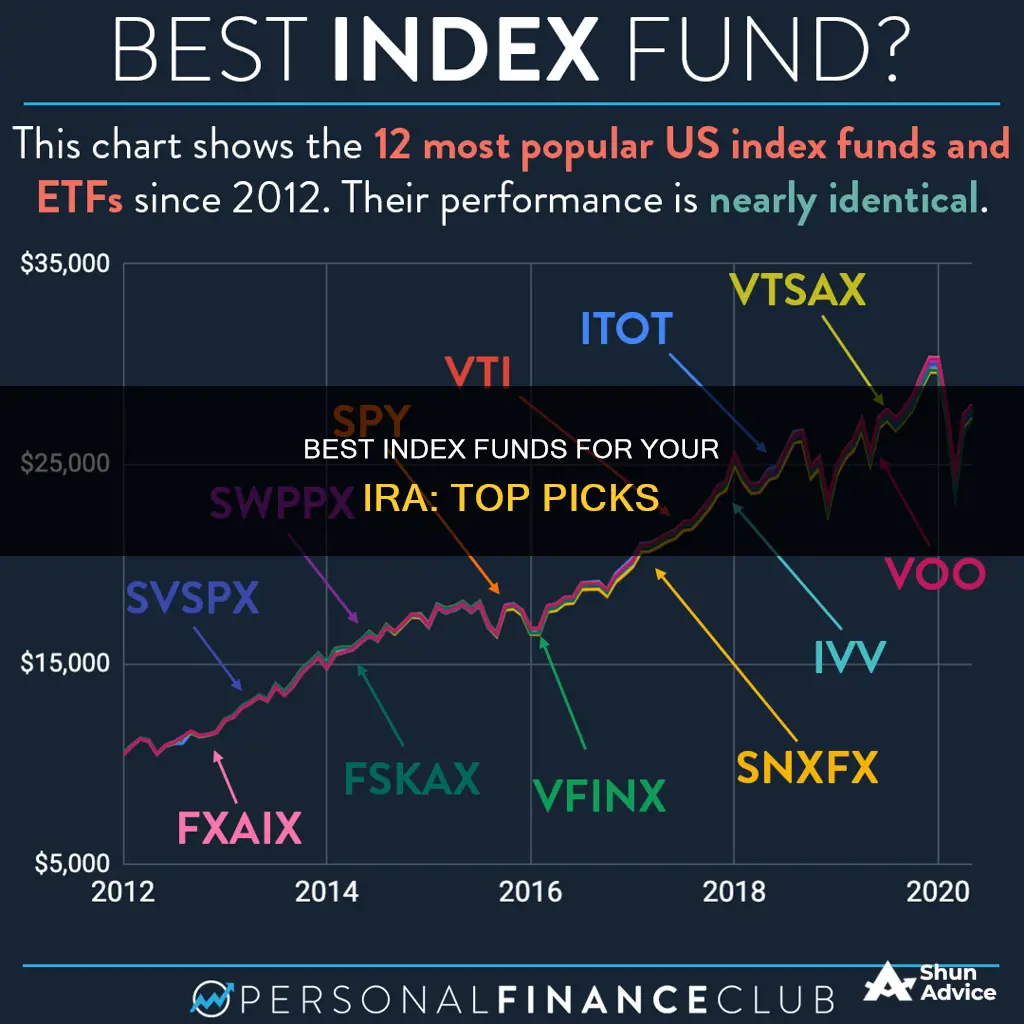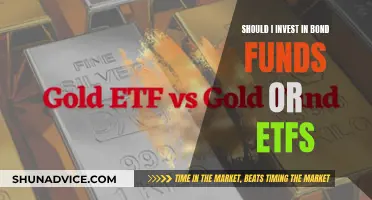
Index funds are a passive investment option that tracks an index with the aim of replicating its performance minus expenses. They are a great investment for building wealth over the long term, which is why they are popular with retirement investors. Index funds are also good for beginners as they don't require much knowledge about investing or financial markets to do well.
When it comes to investing in index funds for an IRA, it is important to consider the impact of taxes on investment returns. While a traditional IRA requires distributions at age 73, a Roth IRA does not. This makes a Roth IRA a powerful vehicle for long-term growth without the drag of taxes.
- Vanguard Wellesley Income Fund Investor Shares (VWINX)
- Vanguard Total Stock Market Index Fund Admiral Shares (VTSAX)
- Fidelity Blue Chip Growth Fund (FBGRX)
- Schwab U.S. REIT ETF (SCHH)
- Avantis Moderate Allocation ETF (AVMA)
- iShares Bitcoin Trust ETF (IBIT)
- SPDR Bloomberg High Yield Bond ETF (JNK)
What You'll Learn

US stock index funds
Fidelity ZERO Large Cap Index (FNILX)
This fund is part of Fidelity's foray into mutual funds with no expense ratio. While it doesn't officially track the S&P 500, it follows the Fidelity U.S. Large Cap Index. This means that Fidelity doesn't have to pay a licensing fee to use the S&P name, keeping costs lower for investors. The fund has a 5-year annualized return of 15.7%.
Vanguard S&P 500 ETF (VOO)
This fund, backed by Vanguard, tracks the S&P 500 index and is one of the largest funds on the market with hundreds of billions in the fund. It has an expense ratio of 0.03%, meaning that for every $10,000 invested, you would pay $3 annually. Its 5-year annualized return is 15.6%.
SPDR S&P 500 ETF Trust (SPY)
The SPDR S&P 500 ETF is the oldest ETF, having been founded in 1993. It is among the most popular ETFs, with hundreds of billions in the fund. The fund is sponsored by State Street Global Advisors and tracks the S&P 500. It has an expense ratio of 0.095%, meaning that for every $10,000 invested, you would pay $9.50 annually. Its 5-year annualized return is 15.6%.
IShares Core S&P 500 ETF (IVV)
This fund is sponsored by BlackRock, one of the largest fund companies. It has been tracking the S&P 500 since 2000 and is one of the largest ETFs. It has an expense ratio of 0.03%, meaning that for every $10,000 invested, you would pay $3 annually. Its 5-year annualized return is 15.6%.
Schwab S&P 500 Index Fund (SWPPX)
This fund, sponsored by Charles Schwab, has tens of billions in assets and has a strong record dating back to 1997. Schwab is known for its focus on investor-friendly products, as evidenced by the fund's low expense ratio of 0.02%. For every $10,000 invested, you would pay $2 annually. Its 5-year annualized return is 15.6%.
Understanding IRA Fund Investment Timing
You may want to see also

International stock index funds
- Fidelity Total International Index
- IShares Core MSCI Total International Stock ETF
- State Street Global All Cap Equities ex-US Index
- Vanguard FTSE All-World ex-US ETF/Index
- Vanguard FTSE All-World ex US Small-Cap ETF
- Vanguard International Dividend Appreciation ETF/Index
- Vanguard Total International Stock ETF/Index
- Vanguard Total World Stock ETF
These funds provide exposure to a broad range of international markets, including established markets in Europe and Asia, as well as emerging markets such as China, Mexico, and Brazil.
When choosing an international stock index fund, it's important to consider your risk tolerance and investment goals. Some funds may carry more risk due to their focus on emerging markets, while others may offer a more balanced approach by investing in a mix of developed and emerging markets.
Additionally, be sure to research the fees and expenses associated with each fund to ensure they fit within your investment budget.
Hedge Funds: Investment Firms or Something Different?
You may want to see also

Bond index funds
Fidelity U.S. Bond Index Fund (FXNAX): This fund offers expansive diversification with about 9,000 bonds. It has a low expense ratio and minimal credit risk, making it a sound choice for investors.
Vanguard Total Bond Market Index Fund Admiral Shares (VBTLX): VBTLX is one of the oldest bond index funds, offering a highly diversified portfolio of over 10,000 bonds. It has a low expense ratio of 0.05% and a duration of about six years, making it a stable option during market volatility.
Schwab U.S. Aggregate Bond Index Fund (SWAGX): SWAGX is a strong contender for the best total bond market index fund. It has a low expense ratio and no required minimum investment. The fund has a turnover ratio of 58%, indicating a willingness to replace lower-yielding bonds with higher-rate assets.
Fidelity Sustainability Bond Index Fund (FNDSX): FNDSX is designed for investors who want an intermediate bond fund that pursues ESG (environmental, social, and governance) investing goals. The fund holds investment-grade fixed-rate debt issues that meet certain ESG standards and has a turnover ratio of 55%.
TIAA-CREF Bond Index Advisor (TBIAX): TBIAX is a core U.S. bond index fund that tracks the Bloomberg Barclay's U.S. Aggregate Bond Index. It aims to get most of its total return from income and uses a quantitative strategy to minimize trading costs. The fund has diversified holdings of more than 8,500 bonds, including government securities and mortgage-backed securities.
When investing in bond index funds, it is important to consider your financial goals, risk tolerance, and investment horizon. These funds offer a convenient and cost-effective way to gain exposure to the bond market and are a popular choice for retirement savings and taxable investment portfolios.
Income-Based Investment Funds: How Do They Work?
You may want to see also

Nasdaq-100 index funds
Shelton NASDAQ-100 Index Direct (NASDX)
This mutual fund began trading in 2000 and has delivered strong returns over the last five and ten years. It has an expense ratio of 0.52%, which means that investors will pay $52 annually for every $10,000 invested. NASDX can be purchased directly from the fund company or through most online brokers.
Invesco QQQ Trust ETF (QQQ)
The Invesco QQQ Trust ETF is a popular choice for investors looking for exposure to the Nasdaq-100 index. This fund started trading in 1999 and is managed by Invesco, a well-known fund company. With an expense ratio of 0.20%, investors will pay $20 annually for every $10,000 invested. QQQ can be purchased directly from Invesco or through online brokers.
Invesco Nasdaq 100 ETF (QQQM)
The Invesco Nasdaq 100 ETF is a cheaper alternative to the QQQ fund, with an expense ratio of 0.15%. This means that investors will pay $15 annually for every $10,000 invested. QQQM was launched in October 2020 and has already accumulated over $30 billion in assets. It can be purchased directly from Invesco or through online brokers.
Victory Nasdaq-100 Index Fund (USNQX)
The Victory Nasdaq-100 Index Fund is a lesser-known option that was launched in October 2000. Despite its strong performance, it has a fraction of the assets of other funds. USNQX has an expense ratio of 0.42%, which is higher than some other options but still below the category average. It can be purchased through online brokers.
Invesco ESG Nasdaq 100 ETF (QQMG)
The Invesco ESG Nasdaq 100 ETF is a socially responsible investment option that invests in Nasdaq-100 stocks that meet certain environmental, social, and governance (ESG) criteria. This fund was launched in October 2021 and has $61.4 million in assets under management. QQMG has an expense ratio of 0.15%, meaning investors will pay $15 annually for every $10,000 invested. It can be purchased through online brokers.
SBI Mutual Funds: A Guide to Investing in India
You may want to see also

S&P 500 index funds
Vanguard 500 Index Fund - Admiral Shares (VFIAX)
Often referred to as the granddaddy of all index funds, this fund was founded in 1976 and gives you exposure to 500 of the largest US companies, which make up about 75% of the total US stock market value. It has a low expense ratio of 0.03%, meaning you pay only $3 annually for every $10,000 invested.
Schwab S&P 500 Index Fund (SWPPX)
This fund is one of the cheapest S&P 500-tracking funds available, with an expense ratio of just 0.02% and no minimum investment required. Launched in 1997, it's a great option for cost-conscious investors.
Fidelity 500 Index Fund (FXAIX)
Fidelity removed the investment minimum on this fund, making it accessible to investors with any budget. Founded in 1988, it has a solid track record and is a good choice for those looking for a low-cost index fund.
Fidelity Zero Large Cap Index (FNILX)
Fidelity made waves by offering this fund with no annual expenses, meaning you can keep all your cash invested for the long term. It's one of the cheapest S&P 500 index funds available.
T. Rowe Price Equity Index 500 Fund (PREIX)
With a competitive expense ratio, this fund was founded in 1990 and has a solid track record. However, it does have a higher investment minimum of $2,500, which may be a steep requirement for beginning investors.
When choosing an S&P 500 index fund, it's important to consider factors such as expense ratios, investment minimums, dividend yields, and the fund's track record. By selecting a fund with low fees and strong performance, you can maximize your returns over time.
Best IRA Funds: Where to Invest Your Money
You may want to see also
Frequently asked questions
Index funds are a great investment for building wealth over the long term. They are less risky than individual stocks because they hold baskets of investments that track a market index, such as the S&P 500. Index funds are also passively managed, meaning they don't need to actively decide which investments to buy or sell, and they are cheaper to run than actively managed funds.
Some of the best index funds to invest in include the Vanguard S&P 500 ETF, the SPDR S&P 500 ETF Trust, the Vanguard Russell 2000 ETF, the Vanguard Total Stock Market ETF, the Fidelity ZERO Large Cap Index, the Vanguard Growth ETF, and the SPDR S&P Dividend ETF.
When choosing an index fund to invest in, it is important to consider the fund's expense ratio, investment minimum, and the degree to which it tracks its underlying index. It is also important to ensure that the index fund aligns with your investment goals and target market segment.







